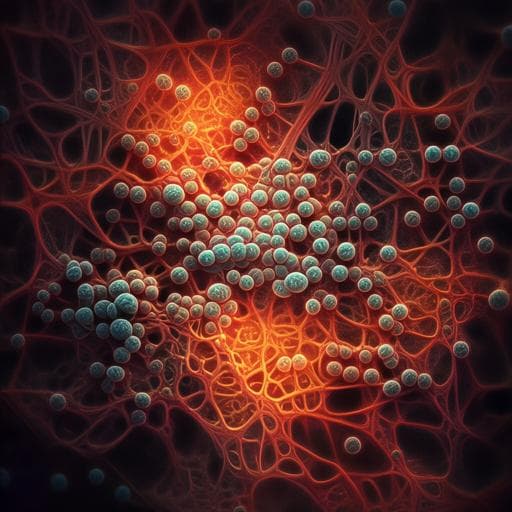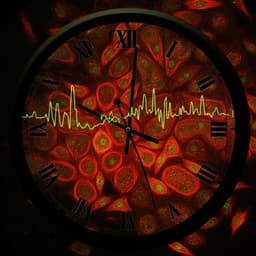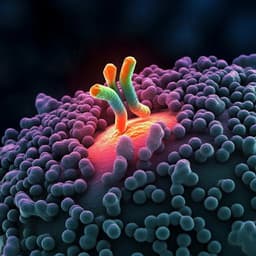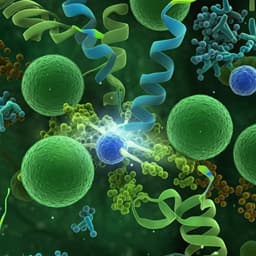
Medicine and Health
Pregnancy-specific responses to COVID-19 revealed by high-throughput proteomics of human plasma
N. Gomez-lopez, R. Romero, et al.
This groundbreaking research reveals how pregnancy alters the immune response to COVID-19, highlighting the distinct proteomic changes that may safeguard pregnant women from severe disease impacts. Conducted by a team of experts including Nardhy Gomez-Lopez and Roberto Romero, this study uncovers crucial insights into the risk factors for adverse outcomes in pregnant women facing COVID-19, paving the way for better understanding and care.
~3 min • Beginner • English
Introduction
The study addresses why pregnant women experience higher risks of severe outcomes, including ICU admission, mechanical ventilation, death, and obstetrical complications (preeclampsia, preterm birth, stillbirth) associated with COVID-19. Prior work shows maternal-fetal immune alterations in SARS-CoV-2 infection and suggests pregnant women may be more prone to cytokine storms with neutrophilia and lymphopenia. High-throughput multi-omics has revealed processes driving COVID-19 progression in the general population, and initial pregnancy-focused proteomics suggested increased inflammatory and antiviral signaling with severe disease. However, a comprehensive, pregnancy-specific comparison of plasma proteomics between pregnant and non-pregnant COVID-19 patients using an expanded aptamer-based platform had not been performed. The purpose is to profile the plasma proteome across COVID-19 severities in pregnant vs non-pregnant individuals to identify shared and pregnancy-specific responses and evaluate diagnostic utility.
Literature Review
Multiple investigations have explored SARS-CoV-2 effects on maternal, placental, and neonatal physiology, including immune responses. Studies indicate increased risk of severe outcomes in pregnancy and obstetrical complications. Comparative immune profiling reported higher likelihood of cytokine storm in pregnant patients and characteristic changes (elevated neutrophils, lymphopenia). Multi-omics in the general population identified severity-associated pathways. A prior maternal/cord blood proteomics study (~1,400 proteins) showed increased inflammatory and antiviral signaling in severe pregnant cases and altered neonatal cytokines, but did not delineate differences versus non-pregnant patients. Aptamer-based proteomics (SOMAScan) has been used in obstetrics for pregnancy and complications but not with the expanded v4.1 panel in pathology. There is also literature linking COVID-19 to endothelial dysfunction, coagulopathy, and a cytokine storm, and an epidemiologic association with preeclampsia. These works frame the need for comprehensive proteomic comparison across pregnancy status.
Methodology
Design and participants: Plasma samples were collected in Colombia from Hispanic pregnant women (n=101; 23.2–39.3 weeks) and non-pregnant individuals (n=93; men and women). COVID-19-positive cases: 72 pregnant and 52 non-pregnant; controls: 29 pregnant and 41 non-pregnant. COVID-19 diagnosis was by PCR per clinical protocols; severity categorized by NIH (asymptomatic, mild, moderate, severe, critical). Pregnant participants were enrolled at labor/delivery or clinic visits; non-pregnant individuals at hospital admission for various indications. Ethical approvals obtained; informed consent provided.
Sample handling and proteomics: EDTA blood was processed to plasma (1600×g, 10 min, 4°C) and stored at −80°C. Proteomic profiling used SOMAmer (SOMAScan v4.1; Somalogic, Inc.), quantifying 7,288 analytes (6,596 unique proteins). Experiments were randomized and run blinded. The SOMAmer workflow included binding to immobilized aptamers, biotin-labeling, competitor washes, photo-cleavage, re-capture with streptavidin, denaturation release, and quantification via custom DNA microarrays (Cy3 signal). Somalogic performed ANML normalization and calibration.
Statistical analysis: RFU values were log2-transformed. Demographics: categorical as counts/percent; continuous as medians (IQR); Fisher’s exact and Wilcoxon tests, two-tailed, p<0.05. PCA: prcomp in R on log2 data; PCs 1–3 related to COVID-19 and pregnancy via linear models with interaction; dose-response with ordered severity factor (Control, Asymptomatic, Mild, Moderate, Severe, Critical) adjusting for pregnancy status, age, sex. Proteins contributing to PCs were interpreted by GO enrichment.
Differential abundance: limma models with covariates. Pregnant analyses adjusted for maternal age, BMI, gestational age (linear and quadratic). Non-pregnant analyses adjusted for age, BMI, sex. Significance: fold change >1.25 and FDR q<0.1. Spearman correlations assessed similarity across severity groups and between pregnancy statuses. Proteins with opposite dysregulation between pregnant vs non-pregnant were defined by significant change (q<0.1, FC>1.25) in one group and opposite-direction nominal change (p<0.05) in the other.
Enrichment: Entrez gene mapping and GO biological processes; Fisher’s exact with FDR q<0.1 and ≥3 hits; MSigDB C2 canonical pathways also tested using GOStats/Bioconductor.
Machine learning: Random forest models (randomForest in R) using up to 50 proteins selected by variable importance; performance via leave-one-out cross-validation; ROC/AUC via PROC package. Models trained overall, by pregnancy status, and by severity categories.
Key Findings
- Global proteome structure: Pregnancy status was a major source of variability (PC2, 18% variance) perfectly separating pregnant from non-pregnant (p<0.001) with enrichment for pregnancy-related processes. COVID-19 status dominated PC1 (27%) and PC3 (6%) across both groups (p<0.001), with enrichment for exocytic process (PC1) and antiviral/innate immune responses (PC3). The COVID-19-induced proteomic shift was larger in non-pregnant vs pregnant (interaction p<0.005), and PC3 showed a dose-response with severity (p<0.001, linear and quadratic).
- Differential proteins by severity (pregnant vs controls, adjusted): Asymptomatic 68 proteins; Mild 81; Moderate 242; Severe 144; Critical 1,072. Less severe groups’ fold changes were attenuated vs critical with positive correlations to critical: r=0.34 (asymptomatic), 0.72 (mild), 0.87 (moderate), 0.88 (severe); p<0.001 each.
- Differential proteins by severity (non-pregnant vs controls, adjusted): Moderate 21 proteins; Severe 1,961; Critical 2,966. Attenuation and strong correlations vs critical: r=0.84 (moderate), r=0.94 (severe); p<0.001.
- Shared core and dampening in pregnancy: 486 proteins were significantly and consistently perturbed in both pregnant and non-pregnant cases with similar directionality, clustering into processes with increased inflammatory/antimicrobial mediators and decreased proteins in other clusters. For the same severity, changes were diminished in pregnancy (regression slopes <1.0; moderate slope=0.80, r=0.79; severe slope=0.58, r=0.86; critical slope=0.78, r=0.63; all p<0.001).
- Enrichment differences: Pregnant COVID-19 cases showed fewer enriched processes, including extracellular matrix organization, defense and immune responses. Non-pregnant cases showed broader enrichment including protein localization/transport, peptide biosynthesis, translation. Shared responses included cell adhesion, response to wounding, blood coagulation. MSigDB C2 pathways: pregnant enriched for ECM and antiviral pathways; non-pregnant enriched for platelet activation, VEGF, PDGF; shared virus- and cancer-related pathways.
- Opposite-direction proteins: 33 proteins showed opposing regulation between pregnant and non-pregnant COVID-19 patients, involving angiogenesis and inflammatory mediators. sFLT-1 (VEGF-sR1) and angiotensinogen decreased with COVID-19 in pregnancy but increased in non-pregnant (potentially due to higher pregnancy baseline). Pregnancy-specific regulation was enriched for vasodilation, angiogenesis, and inflammatory response pathways.
- Shared increases regardless of pregnancy: TNFRSF1B (soluble TNF receptor II) and VWF increased with COVID-19 in both groups. NET-associated proteins ELANE (neutrophil elastase) and histone H3.1 (H3C1) were elevated in both.
- Cytokine/chemokine profiles: IL-6 increased in both; IL-1β and IL-18 increased but did not reach significance in pregnant (p=0.074 and 0.052, respectively). TNF and IL-17A upregulated in non-pregnant with slight trends in pregnancy. IL-1α decreased in pregnancy (trend similar in non-pregnant). IFNγ reduced in non-pregnant but not in pregnant. IL-10 decreased and TGFβ1 increased in both. CXCL10 increased and CCL22 decreased in both; CCL1 reduced and CXCL13 increased only in non-pregnant (pregnant showed similar tendencies). Overall, cytokine storm features were present but dampened in pregnancy.
- Diagnostic modeling: Random forest proteomic models distinguished cases from controls with high accuracy: AUC=0.978 overall; AUC=0.974 in pregnant; AUC=0.985 in non-pregnant. By severity: severe/critical vs control AUC=0.99; moderate vs control AUC=0.94; asymptomatic/mild vs control AUC=0.95. Top contributors included ISG15, MX1, ZBP1, and IFNL1, consistent across severities.
Discussion
The study demonstrates that COVID-19 elicits robust, severity-dependent alterations in the plasma proteome in both pregnant and non-pregnant individuals, but the magnitude of this response is attenuated during pregnancy. This dampened systemic inflammatory/proteomic response may reflect pregnancy-specific immune modulation aimed at protecting the fetus from harmful inflammation while the placenta contributes antiviral defense, potentially explaining heightened maternal susceptibility to severe disease despite restrained systemic cytokine responses. The shared enrichment for cytokine storm mediators, endothelial dysfunction, and angiogenesis underscores known COVID-19 pathophysiology. Differences in angiogenic and inflammatory profiles, including pregnancy-specific regulation of sFLT-1 and AGT and shared increases of VWF and TNFRSF1B, align with links between COVID-19, coagulation, and endothelial activation and suggest partial overlap with pathways implicated in preeclampsia. The proteomic signature’s diagnostic performance, even in asymptomatic/mild cases, indicates translational potential for risk stratification across pregnancy status. Together, these findings address the research question by identifying pregnancy-tailored immune/proteomic responses to COVID-19 and highlighting mechanisms that may contribute to adverse maternal-fetal outcomes.
Conclusion
This work provides the most comprehensive plasma proteomic characterization of pregnant and non-pregnant individuals with COVID-19 using the SOMAScan v4.1 platform. COVID-19 induces severity-dependent proteomic changes that are dampened during pregnancy, with both shared and pregnancy-specific alterations in cytokine storm, endothelial dysfunction, and angiogenesis pathways. The proteome robustly discriminates COVID-19 status, including mild/asymptomatic disease. These findings clarify distinct immune modulation in pregnancy and offer insight into pathogenesis and the increased risk of severe outcomes in pregnant women. Future studies should define temporal kinetics of proteomic responses relative to infection onset, delineate mechanisms driving pregnancy-specific regulation (including placental contributions), validate biomarker signatures in independent cohorts, and assess implications for offspring health and obstetrical syndromes such as preeclampsia.
Limitations
Key limitations include lack of information on the interval from infection or symptom onset to sampling, preventing assessment of response kinetics; non-pregnant controls were matched to cases by age/comorbidity but not necessarily healthy, limiting comparison to a fully unperturbed baseline; and while proteome profiling may not be practical for diagnosis alone, derived signatures could inform risk scoring in broader studies. External validation and longitudinal sampling would strengthen generalizability.
Related Publications
Explore these studies to deepen your understanding of the subject.







